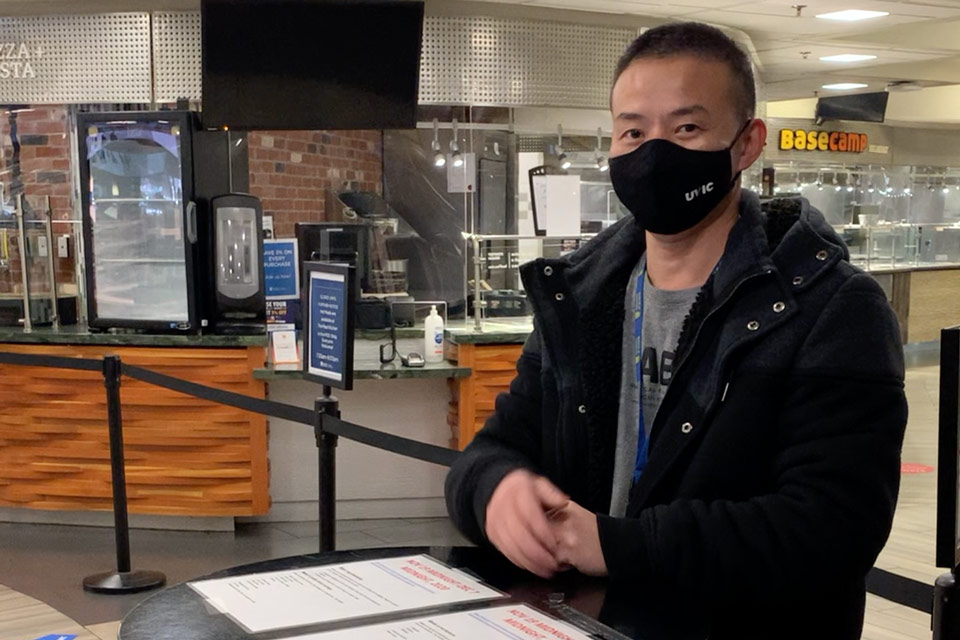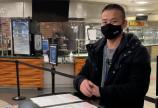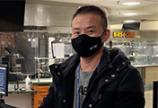Keeping campus safe with an eye on the future
- University of Victoria

As a Food Services employee for the past 10 years, Paula Burns never imagined that her daily routine would be upended by a previously unknown virus. When the shift to remote learning and working happened suddenly in the spring and UVic scaled back service at its retail food outlets, Burns was temporarily laid off.
Almost as rapidly, Burns was asked if she would be interested in being redeployed on campus in the new Classroom Safety Ambassador program, which launched in September to support face-to-face delivery of classes. As an ambassador for the David Turpin Building, she greets those entering the building, helps students find designated study spaces, cleans high-touch surfaces in those spaces, and provides information about campus safety protocols.
We’re an extra layer of safety on top of all the work that Facilities Management and janitorial does.
—Paula Burns, Classroom Safety Ambassador
More than that, though, the ambassador program allows both staff and students to stay connected. “A lot of students were isolated and didn’t have much contact with other people. People feel really grateful to have a chat when they come in, even if it’s once a week. It’s been like a lifeline to many students and makes a big difference in my life too—it’s been a real eye opener.”
With 57 ambassadors in 14 buildings across campus, the ambassador program is helping the university maintain safe campus operations while the majority of students, faculty and staff work and study remotely.
At the same time, planning is underway to envision how the campus will look in summer 2021 and beyond. AVP Human Resources Kane Kilbey is cautiously optimistic about the new year, noting that leaders continue to “discuss different approaches for getting more students, faculty and staff back to campus as soon as it is safe to do so.”
Campus operations and services have been maintained over the past several months by a core group of staff from areas such as Facilities Management, Campus Security, Custodial Services, University Systems, Athletics and Recreation, the Bookstore, Child Care Services, Food Services and Residence Services. It’s estimated that approximately 20 per cent of staff in departments and units are working on campus at least part of the time. That number is expected to steadily rise as the COVID-19 vaccination program rolls out across the country.
According to Andy Mavretic, director of occupational health, safety and environment, more than 500 safe work plans have been approved or are in progress for university classrooms and studios, research and research centres, specialized units and office environments.
“Our campus community has worked well together to safely re-open research and creative work spaces, which are so critical to upper-level undergraduate and graduate learning,” says Rachael Scarth, associate vice-president research services.
Approximately 3,500 students were enrolled in face-to-face classes in the fall term, in courses with a significant experiential learning component, such as theatre production, visual arts, chamber music, ecological restoration, organic chemistry and engineering drawing. Work-integrated learning opportunities, including practica, clinical placements, field experiences, law clinics, community placements and co-op, also continued.
To ensure equitable access to student services, many support services—including counselling, health and academic advising—were made available virtually, along with the Learn Anywhere online student portal and the SupportConnect program, which provides 24/7 confidential mental health supports for students by phone or online.
The New Student Connect program, which pairs first-year students with volunteer upper-year student mentors, also kicked off in the fall. “Having an amazing experience outside the classroom is part of the reason students choose a university,” says Angi Ross, program manager for new student engagement in the Office of Student Life. “We’re trying to create and hold a virtual space to build up the student body, and make it as accessible as possible.”
With the goal of helping new students build connections to UVic within a new virtual community, the upper-year Engage Leaders lead online events and activities and provide supportive guidance and resources, offering weekly posts and chats, monthly activities such as games, movie or meditation nights, individual check-ins and a variety of “pods” (e.g., international, LGBTQ2, mature students, Indigenous) that students can join.
We know that students want to maintain their connections to UVic, and that faculty and staff also miss interacting with students in person. We are prioritizing everyone’s health and safety. We want to welcome more students to campus as soon as we are safely able to do so, and we hope to offer more opportunities for face-to-face educational activities this summer.
—Susan Lewis, acting vice-provost
Campus is expected to continue to look different for some time, with ongoing opportunities for innovative and interactive learning. This means courses may offer both face-to-face and online components, while services may be available both in-person and remotely.
“We will work toward having all university employees return to campus at least on a part-time basis by summer or fall 2021, as the health guidelines allow,” says Kilbey. “As a destination university, we know how important it is for UVic to offer a full range of activities and services on campus, and we want to make sure we get there safely.”


